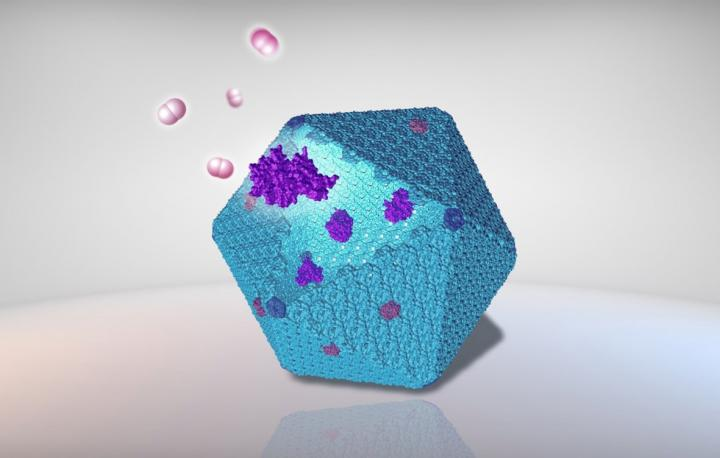Nov 4 2020
A group of scientists from the University of Liverpool has revealed new possibilities for the upcoming development of clean, sustainable bioenergy.
 Illustration of a carboxysome and enzymes. Image Credit: Professor Luning Liu.
Illustration of a carboxysome and enzymes. Image Credit: Professor Luning Liu.
Published in the Nature Communications journal, the study demonstrates a method through which hydrogen can be produced by reprogramming bacterial protein “cages” as nanoscale bioreactors.
The unique bacterial organelle, carboxysome, encapsulates the crucial CO2-fixing enzyme called Rubisco into a protein shell that resembles a virus.
The semi-permeability, naturally designed architecture, and catalytic enhancement of carboxysomes have resulted in the practical design and engineering of novel nanomaterials to integrate different kinds of enzymes into the shell for improved catalytic performance.
The initial step in the research work required investigators to install particular genetic elements into the industrial bacterium Escherichia coli (E. coli) to create empty carboxysome shells. The researchers also detected a tiny “linker”—known as encapsulation peptide—that can direct external proteins inside the shell.
Hydrogenases are enzymes that catalyze the production and conversion of hydrogen. The highly oxygen-sensitive trait of these enzymes has been a long-standing problem for producing hydrogen through bacteria. Therefore, the researchers designed new techniques to integrate catalytically active hydrogenases inside the empty shell.
Our newly designed bioreactor is ideal for oxygen-sensitive enzymes, and marks an important step towards being able to develop and produce a bio-factory for hydrogen production.
Luning Liu, Study Lead and Professor of Microbial Bioenergetics and Bioengineering, Institute of Systems, Molecular and Integrative Biology, University of Liverpool
In association with Andy Cooper, a Professor in the Materials Innovation Factory (MIF) at the University of Liverpool, the team subsequently validated the hydrogen-production activities of the biochemically isolated nanobioreactors as well as the bacterial cells.
The nanobioreactor attained an improvement of around 550% in terms of hydrogen-production efficiency and a higher oxygen tolerance when compared to the enzymes without the encapsulation of the shell.
The next step for our research is answering how we can further stabilise the encapsulation system and improve yields. We are also excited that this technical platform opens the door for us, in future studies, to create a diverse range of synthetic factories to encase various enzymes and molecules for customised functions.
Luning Liu, Study Lead and Professor of Microbial Bioenergetics and Bioengineering, Institute of Systems, Molecular and Integrative Biology, University of Liverpool
Tianpei Li, the study’s first author and PhD student, stated, “Due to climate change, there is a pressing need to reduce the emission of carbon dioxide from burning fossil fuels. Our study paves the way for engineering carboxysome shell-based nanoreactors to recruit specific enzymes and opens the door for new possibilities for developing sustainable, clean bioenergy.”
The study was financially supported by the Royal Society, Biotechnology and Biological Sciences Research Council (BBSRC), British Council Newton Fund, and Leverhulme Trust.
The study was also conducted in association with the Centre for Cell Imaging, Centre for Proteome Research and Biomedical Electron Microscopy Unit at the University of Liverpool, along with scientists from Henan University and Central South University in China.
Journal Reference:
Li, T., et al. (2020) Reprogramming bacterial protein organelles as a nanoreactor for hydrogen production. Nature Communications. doi.org/10.1038/s41467-020-19280-0.